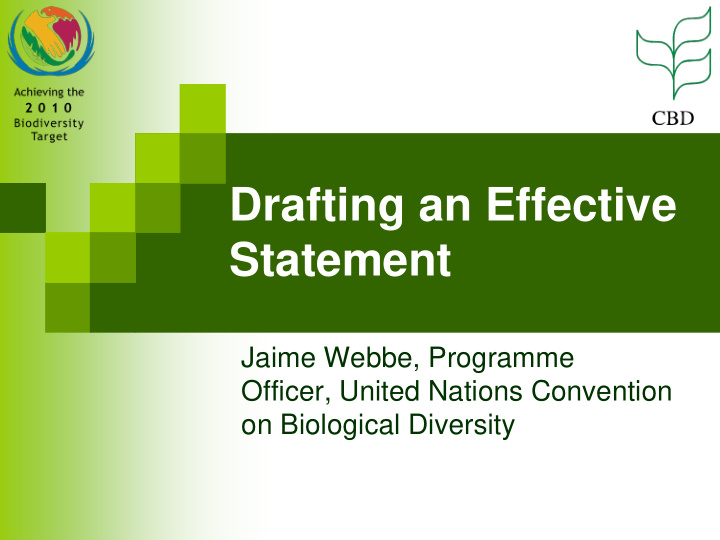



Drafting an Effective Statement Jaime Webbe, Programme Officer, United Nations Convention on Biological Diversity
Introduction You have a unique opportunity to influence policy � This opportunity is driven by your knowledge, � convictions and efforts During this presentation remember: � Respect your voice… � � …but remember your audience � Listen to others… …but don’t be afraid to speak up �
Step 1: Building a Constituency Who are you speaking on behalf of: � Where are they from? � How old are they? � � How do they see the world? How are you communicating with your constituency: � � Internet? � Community meetings? Newsletter? �
Do… Be as inclusive as possible � Be open, transparent and fair � Listen to all views � Don’t… Speak on behalf of people who haven’t agreed � to be represented Assume that a constituency should be � homogenous
Step 2: Building Consensus � What are the three most important decisions that politicians should make to safeguard biodiversity? Ensure that ecological services are properly accounted for in GDP and other economic considerations Better integration of ecological services into the education systems, as well as the creation of more “green-collar” jobs in which people can benefit directly from sustaining the biodiversity around them Promote the creation of large protected areas networks
Do… Start with all options on the table � Identify common threads � Try to group views into common headings � Don’t… Bully � Give in to “spoilers” �
Step 3: Prioritizing � What are the most important messages to get across? Questions to ask yourself: - Which points require the most immediate action? - Which points match with what your intended audience will be discussing in the near future? - What are the consequences of no action?
Do… Play with wording � Build ownership � Don’t… Assume that everything is a priority � Forget the diversity of your constituency �
Step 4: Drafting Be Concise… Dignity, and even holiness too, sometimes, are more questions of coat and waistcoat than some people imagine. He would make a lovely corpse. …But Make Sense It was the best of times, it was the worst of times.
Step 4: Drafting Be Scientific… The IPCC Report highlights the increased extinction risks that species will face as a result of climate change …But Not Confusing The fourth assessment report of the Intergovernmental Panel on Climate Change, in a new finding since the third assessment report, states with medium conference that approximately 20 – 30% of plant and animal species assessed so far are likely to be at increased risk of extinction if increases in global average temperature exceed 1.5 – 2.5°C.
Step 4: Drafting Be Relevant… 3 Objectives of the Convention Programmes considered for in-depth review Access and Benefit Sharing …But Don’t Ignore Important Issues You are the authors of your own message
Do… Consider your audience � Test your messages � Be ambitious � Don’t… Provide a Christmas list � Forget the action �
Step 5: Delivery � Ask yourself: � Who’s going to be listening? � How will you measure their response? � What would you consider to be a successful outcome? � How can you transmit the un-written elements of your declaration (e.g. the breadth of your constituency, the reasons behind your statements, etc)
Do… Be creative � Be confident � Don’t… Be overly complex � Distract from the message �
Recommend
More recommend